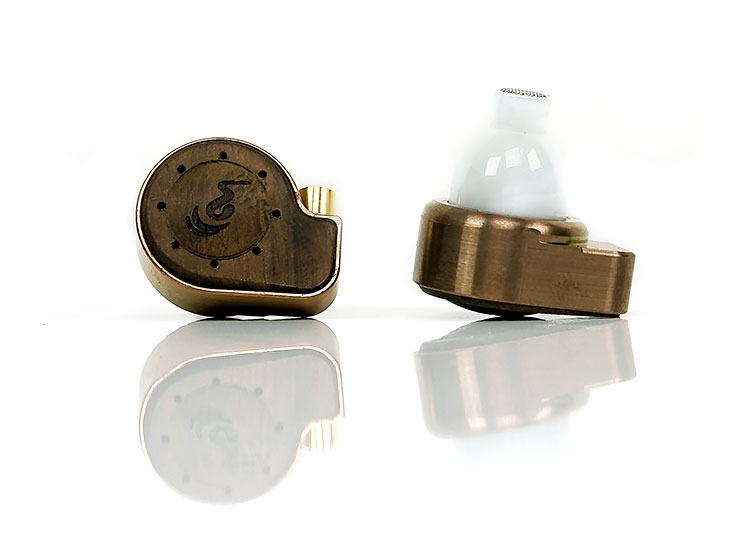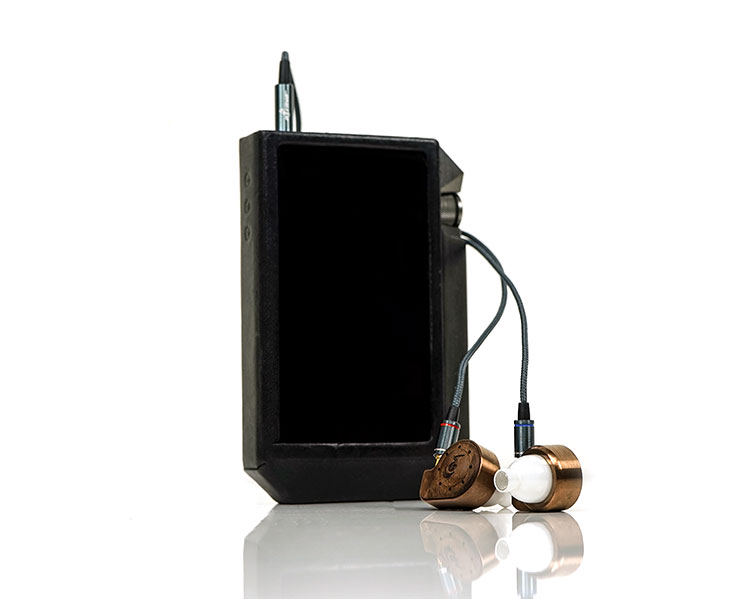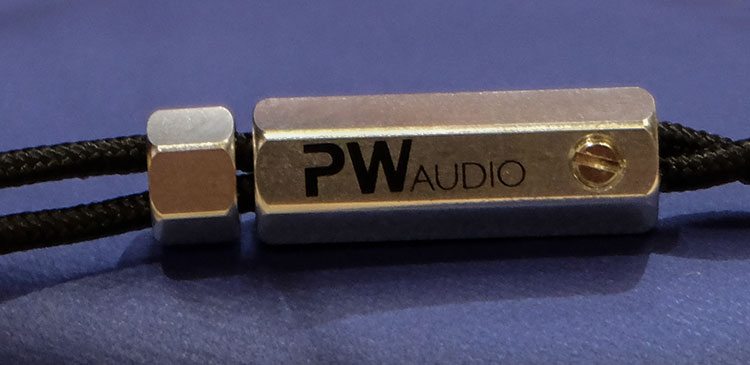Synergy
Normally, I would just come straight out and tell you how it sounds. However, the Ra C-Cu requires a really careful or studied approach to gear synergy before you can really get to grips with its potential.
Different setups produce very different sounds and as such, it is important to consider what you will connect it to before taking the plunge.
The signature we are describing below came about after 2 months of intensive matching. We studied the sources, amps, tips, cables, and finally the ideal genre of music it will sound at its best.
The Ra C-Cu is one of those sound signatures that really does change quite substantially depending on your setup.
Power
DAPs
Most DAPs and smartphones are out, especially if you want to retain control and resolution in the Ra’s signature. I found DAPs weaker signal either to be veiled in the mids and vocals with a loss of openness and resolution or left a jarringly bright upper mids and lower treble response.
Even flagship DAP’s such as Sony’s 1Z produced an abundance of sharp partial overtones, particularly on percussion timbre that made the signature much too fatiguing and unnatural sounding. The lack of power seems to “disconnect” the hybrid tuning into almost two separate drivers competing for your attention.
There was one ‘DAP’ that produced a very special sound for me. It is not strictly a DAP though, it is the Sony PCM-D100. This is technically a pro-recorder but its audio playback is superb.
The power on the D100 is a bit more than most DAPs but not overkill for the Ra C-Cu which sat nicely around mid-way (4-5 on the volume dial). It has a very pure and neutral to natural sound that gels just perfectly with the Ra.
Read The Specs
Take a gander at the technical specifications for your first hint of the potential setup you will need. The Ra C-Cu is rated at no less than 182Ω and 105dB which really means you need some quality power to get the best out of the hybrid driver design.
The 105dB will fool you though if you plug it into a weak source. It may sound ok actually and you will get decent volume on initial impressions such as the case with my humble iTouch 6th gen. However, I can assure you is that is not going to do the Ra C-Cu any justice at all.
Synergy
Ideal Amp Tone
Our time with the Ra C-Cu led me to the conclusion that the power requirements are almost desktop in nature but at the same time pure grunt is not the be-all and end-all.
We plugged it into a 7W balanced desktop amp expecting exciting results and yet left feeling not so satisfied with the tone. Whilst the detail was incredible the tone was way too clean and overcooked the top-end to the point where it started to sound maybe too sharp.
The Ra’s harmonic balance can easily shift in favor of 3rd or 4th order if you are not careful. Solid-state amps, particularly those that err towards neutrality, usually did not present the best synergy.
The best results came from tube amps because of their generally superior 2nd order harmonic distortion. This produced a more pleasing and smoother element into the tonal balance of the Ra. I will also give a nod to Xi Audio’s Formula S and Chord’s Hugo 2 using filter 4.
The Formula S is a beautifully smooth-sounding solid-state Class A amp that paired well with the Ra C-Cu using a tube-designed or warmer DAC. The Hugo 2’s warmer high roll-off filter no 4 also produced a fairly balanced and smoother sound with the Ra.
Ideal DAC Tone
Further to that, you do have to reach back to your DAC feeding into your amps for synergy fine-tuning. A NOS DAC or even a DAC with a traditionally warmish tone will deliver a more natural sound to the Ra C-Cu than a pure solid-state clinically neutral setup.
Despite the slight loss of detail, the tonal synergy of ALO Audio’s tube-based Continental Dual Mono and its WM8741 DAC implementation was one of the best small tube setups I heard with the Ra.
If you find the amping side of the CDM to be slightly lacking you can always hook the CDM up as your tube DAC to something like ALO’s own Studio 6 tube amp for some stellar results.
Tips Rolling
Foam vs Silicone
I had mentioned on the last page that I preferred the Comply’s over the single bore silicone tips because of the additional seal. That remains true for the last 2 months. I tried a few other foam variations but they did not add much or take away much from the core Comply signature.
The Comply’s leak far less than the silicone versions and retain more body from the low-end end into the mids. They also do a much better job at smoothing out the treble which is very clear but also very energetic.
The silicone tips level of leakage accentuates the perception of treble because of the loss of body and warmth in its lower-end. It simply becomes too clean and the timbre is too bright as a result.
Custom Tips
If you take it a step further to the custom tips from Snugs then take everything I said about the Comply advantage and double it. The silicone custom tips produce the best seal possible for a semi-open design and bring in a very natural tone.
The vocals in particular benefit from the tips with some fantastic realism and very detailed texture.
Does it attenuate a bit too much on the top end as a result or make it too warm and inviting? In a word no. I originally thought they might but comparing both it is more down to the level of leakage from the Comply tips being greater than the silicone custom tips. It honestly makes a huge and positive difference.
Cable Swapping
The minute soldering surface area of the MMCX connectors on the Ra C-Cu makes cable upgrades few and far between. I know oBravo is working on pulling out a line of approved cable varieties as we speak so watch out for that in the coming months.
PW Audio 1960s
Working with Music Sanctuary directly though we did find one cable that produced excellent results and that was the PW Audio 1960s 2-wire. Quite apart from the obvious build quality upgrade the 1960s 2-wire radically improved the articulation and resolution of the Ra C-Cu over the stock cable.
The 1960s will, however, retain a much more neutral tone so that is something to be aware of. It gave up a little warmth in the process so if you prefer more euphonic or not as fussy about extracting even more detail from the Ra C-Cu then the stock will be ok.
However, if you are after lighting quick and immersive imaging, impressive dynamic range, and a much bigger soundstage then I would go for this upgrade.
Connectors
Music Sanctuary can offer balanced, 4.4mm and 3.5mm terminations and I would recommend the 2.5mm and grab a 4.4mm short-throw converter for portable amping from the likes of Sony, iBasso, and Fiio who offer 4.4mm compatible amp cards.
If you are upgrading with a view to connecting to full-scale desktop amps I would also advise making your cable at least 1.5m rather than the usual 1.2m. Stock balanced can be used but I found it much too short unless the amp was right in front of you.
The final suggestion on matching the Ra C-Cu is to hop on the “intertubez” and grab a 2.5mm to XLR 4-pin converter. This is likely a custom job but it will open up the Ra C-Cu to balanced amp outputs and additional power where required.
I do not think it is wholly necessary as some single-end amps sound very sweet indeed with the Ra. However, at around $20-50 for the converter its not much of an outlay for a useful tool.
Sound Impressions
Summary
The Ra C-Cu has a unique signature and not one that is easily boxed into normative IEM sound descriptions. I personally find it a lot more complex because of that hybrid driver synergy. The phrase that does come across in my thoughts constantly is “speaker-like” in its presentation.
There is the faintest of n-shaped responses though with an upper-mids elevation around 2-4k that allows the Ra C-Cu to paint an incredibly detailed but slightly forward vocal reproduction.
Treble energy is ever-present with a level of speed and articulation that is electrostatic in quality and just as ethereal in tone and weight.
The bass response is finely balanced and largely linear sounding, especially from 100Hz up to 1k. If you also think that means the bass may be lean sounding further below 100Hz then you would be dead wrong. The impact and control on the Ra’s low-end are wonderfully defined and snappy right down to 30Hz.
This is an excellent example of how you simply do not have to elevate bass quantity to get a strong sense of depth. It is possibly the purest bass response I have heard to date on an IEM, period.
If there is any low-end deviation it is a slightly north of neutral rise into the lower-mids instead of the usual dipping but not by much, maybe 1dB max.
If you are expecting instrumental clarity to take any sort of hit from that subtle elevation then think again. The instrumental timbre on the Ra’s presentation up to the upper mids is beautifully clear and very natural sounding.
Soundstage
Immense But Not Diffuse
The staging is immense with that huge 16mm NDD driver. Not once will you ever feel that the Ra C-Cu was anything less than wide open and very spacious sounding.
However, oBravo has not pulled back the vocal presence to give you a perception of a wider staging quality. It is relatively forward actually, rather the magic is what happens behind those vocals.
This is not a diffuse-sounding presentation where distance equates to vagueness in imaging. The imaging on the Ra C-Cu is incredibly accurate and far more nuanced in how it delivers spatial cues compared to some leading multi-driver IEMs.
Imaging
To give a point of context is the excellent A18 from 64 Audio. I have always remarked on how intricate and controlled its imaging can be. As good as it is with the A18 the Ra C-Cu has a more 3D-like presentation. There is simply more headroom and space to work with.
As result, you get a very definite sense of the exact layout of the stage in front of you. You can tell the AMT 8II driver is working some additional headroom and air ensuring the Ra C-Cu has plenty of space to work with.
A good example of this is the haunting ‘Sister’ By Haux from their “All We’ve Known” EP. Woodson Black’s vocal is tenor pitched possibly higher with a slight falsetto.
However, in the mixing, there is a heavy reverb on the vocal designed to replicate singing in an empty hall without any acoustic padding. Essentially, it is a hard cold set of walls with the vocal bouncing off creating what I would describe as a ‘fading echo’.
With the A18, the echo comes in quite quickly and is almost on top of the vocal with a very short decay. The effect is more like a hallway where the reverb or echo escapes at the other end of the corridor rather than twist and turn or bounce off the walls.
With the Ra, the hall sounds bigger, much bigger in fact, and the echo sounds like it’s hitting off multiple walls. That additional energy in the final octave of Ra’s presentation makes a huge difference in this song.
Even with the vocal forward and central I never felt the echo was encroaching. Rather, it was properly positioned far enough away to dovetail the vocal with its own unique quality rather than mess with the vocal itself. A nuanced but very important level of detail at this level.
Bass
oBravo has also resisted throwing in an overly colored low-end despite the presumably huge bass potential this 16mm driver could have been tuned to offer. In fact, the Ra C-Cu from around 100hz or so focuses much more on resolution and texture than pure quantity.
This is not Vega or RE2000 like in pure physicality. It is far more nuanced or complex sounding than multi-driver BA driver bass performances. Quite often the Ra’s low-end left flagship BA CIEMs sound flatter and more one-dimensional.
The quality of the Ra’s low-end texture and layering is unbelievably good and the balance, particularly in its length of decay is just so natural sounding. It retains that liquid sound of a great dynamic driver but it resolutely refuses to sound slow, flabby, or overly warmed up.
Example
I found a fantastic example of the performance of the Ra C-Cu low-end with Wild Child’s ‘Sinking Ship’ track from their new ‘Expectations’ Album. If you like a Dido-style female vocal delivery and plenty of folky-ambiance this is a nice album to get by the way.
The majority of the track is pretty much Kelsey Wilson’s female vocal layered over a single acoustic guitar with the odd piano arrangement but nothing heavy. It is quite sparse and melancholic sounding up to the 3rd minute.
Then suddenly they bring in a modern muddy bass beat with that underwater-type sound you tend to hear from artists such as Daft Punk or Air. It is quite a changeup in the low-end but it is not forced or dance-orientated. It is much more subtle than that.
I did a comparison on how the A18 from 64 Audio and UM’s Mason V3 handled this particular changeup compared to the Ra.
From what I heard the Ra C-Cu delivered more detail and a better level of contrast between the vocals and this underlying bass effect. The low-end layering and instrumental positioning combined with the delicate female vocal were more engaging on the Ra as a result.
BA TOTL CIEMS were technically great but the low-end sounded a bit flatter with a more traditional BA feel. I did not get the same level of nuanced detail and layering as the Ra’s bass response.
Mids
The lower mids on the Ra C-Cu are very linear with a tiny rise up to 1k but nothing dipped or thin sounding. The instrumental timbre here is very natural and lifelike and never once sounded cold or sterile.
The harmonic balance of up to 2k is perfect for my ears. Instrumental separation also benefits from that spacious soundstage but at the same time, it does not sound unnatural in its presentation.
There is a very definite level of elevation though around 3k bringing certain vocal pitches and some percussion passages to the fore. Male vocals or any vocal that pitches a little lower from 500Hz to 1k sounds very life-like with fantastic levels of detail and a natural amount of body.
Generally speaking, those vocals that pitch on that 3k elevation will sound as good but only if your amping synergy is properly set up.
Upper Mids
There is a slight dip from 4-6k but you will not get a sense that this range sounds flat or muted because of how open the mids generally sound. However, once you slip into the upper mids they do get more dominant and you do have to start considering your synergy carefully to get the right harmonic balance.
The AMT 8II tweeter can push that upper harmonic order heavily if not controlled since it retains a lot of energy from 8k right up to 15k. If uncontrolled the elevated upper mids can sound a lot harder, sibilant, and generally sharper as a result.
I do recommend a mellower tube amp such as the Alo Audio Continental Dual Mono or the Auris HA-2SE if you need more power. They tend to push 2nd order harmonics more to the fore which produces a very nice balance in the tone of the Ra’s upper mids.
Treble
Beyond the upper mids, you will get more upper harmonics bias, so there is plenty of percussion bite and presence, where amp synergy becomes important. Quite a lot of that comes from the AMT 8II tweeter delivering a sustained level of energy beyond 10k and almost to 15-16k.
Typically, IEM and headphone performances tend to roll off with only minor bumps around 10-12k for air and a touch of sparkle. Not so the oBravo. Air is abundant and sparkle with some astonishing levels of presence in that final octave.
Tonally, this is a clean, very detailed, and articulate top-end. The presentation will sound a bit ethereal and not unlike the IE800’s treble in some ways only its elevation and energy extends much further. As a result, the staging height and level of headroom are incredibly satisfying.
Again, I refer you back to both my interpretation of the Ra C-Cu as being speaker-like in its presentation but at the same time remember that careful amp and source selection will ensure you do not get an overly-cooked and shrill-sounding signature.
Click on Page 3 below for our select comparisons to the Ra C-Cu.





